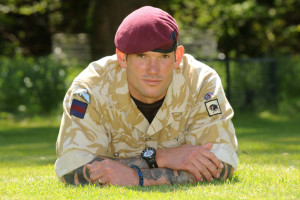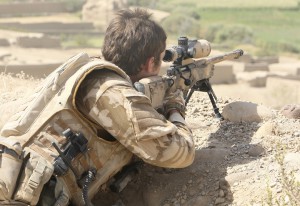by Craig Harrison
The Longest Kill
In the sniper world, we constantly move after firing. A sniper will fire one to two shots, possibly three, from one position, before having to move. If you stay still, you will be identified—and if you are identified, you will be taken out. I had no idea how many rounds I had fired from this position, but it was a lot more than three. I should have moved a long time ago. I didn’t have much choice though. I needed the Jackals on the high ground so that they could use their weapon systems. I couldn’t push away from the vehicles and I really was in the best position to provide support; there was nothing better than this wall in my immediate surrounding area.
Even so, I was in the process of looking for a new position to move to when Wit started shouting behind me, “Craig, Taliban!”
I followed the direction that he was pointing in, but Cliff had beaten me to it. “One Taliban by a water pump on the far right,” he said.
The target was 830 yards away: I hit him and watched him go down. Then I spotted a guy on a motorbike, with an AK47 slung across his back, coming from Three Titted Hill toward the water pump. I gave him a three-mil-dot lead as he was a moving target and fired. I missed.
“Go four-mil-dot lead,” said Cliff.
I fired again and watched with satisfaction as the rider tumbled off and disappeared behind a sandhill. I continued to scan the area in case he got back up.

“Troop leader is starting to bring his vehicles back,” shouted Wit.
The only way for the troop leader to get his vehicles out was to bring them back the way they had come: through the kill zone. The place was crawling with Taliban and the vehicles would be really exposed, but with all the ditches and the treelines, any other route was practically impossible, the ground too hard-going.
I watched their movements through my scope, all the while scanning the surrounding area for enemy. All of the vehicles suddenly stopped and I could see one of lads, Mark, dismount and start to walk round his vehicle. I knew I wouldn’t stop in the middle of a kill zone.
“Wit, talk to me. What is going on?” I called.
“One of the Jackals is bogged in,” he replied. “It looks like the Taliban have been flooding the fields to trap the vehicles. That’s why that bloke was standing by the water pump.”
“Tell them to hold on while I scan the area.”
I’d just started to search around the vehicles when a large weight of fire started up. All of the lads hit the deck.
“Contact, contact,” Wit shouted, relaying what he had just heard on the radio.
Dust was kicked up all around them and I could see Mark trying to get back into his vehicle to get the machine gun to bear, but the fire was just too heavy around him and he was forced to jump into a nearby ditch. Both wagons were pinned down and the lads were really in the shit. We needed to act fast or they were going to start taking casualties. Once you have a casualty, the whole situation gets ten times worse. I needed to work out where all the fire was coming from and I needed to work it out fast.
“Cliff, help me check all of the firing points. We’ve got to help the guys,” I said.
We both started searching all of the previous firing points but they were clear.
“Fuck, fuck, fuck,” I thought to myself, as the fire got worse around the vehicles.
I needed to stay calm. I could feel my heart rate rising and my muscles tensing. I was desperate to help my lads, but would be no use if I couldn’t shoot properly. I took a deep breath and forced myself to relax.
“Where the fuck is that machine gun?” I muttered.

Photo: Rob Kellaway
It suddenly occurred to me that the only place we hadn’t checked was around the dicker. My brain was processing a lot of information very quickly and I started to think about enemy weapon systems. If the fire wasn’t from any of the previous close-in firing points, it must be coming from further away. The machine gun with the longest range that the Taliban had was a PKM, a belt-fed machine gun capable of shooting out to 1,600 yards. The RPK, their other machine gun, was magazine fed and wouldn’t be capable of such high rates of fire. That meant that they had to be . . . on Three Titted Hill.
I brought my rifle round, scanned the area of the far compound where the dicker had been and suddenly I saw them. A Taliban machine-gun team was up on the right-hand side of the compound, pouring fire down on my lads. Whereas I had been happy just to keep the dicker’s head down, I knew I had to get these guys—or they were going to kill one of mine. This time the rounds had to count.
I could feel the pressure and the stress mounting, but I pushed that to the back of my mind. Now, I started factoring in everything. I glanced at my wind markers. They were hanging limply; good, no wind. I was already at maximum elevation on the scope but I dialed twenty clicks left to take account of the spin drift, then factored in the earth’s rotation.
I lifted my head up an inch and then placed it back down, checking my eye relief (how far back my eye was from my scope). I ensured I had a good cheek weld to the stock. The sponge that I’d put on the stock the other day was doing its job, even though it was soaking wet with sweat. My left hand was getting sore from holding on to the scope for so long, but I just had to push through it. The rifle was comfortable in my shoulder and I could feel that I was getting into the most stable position that I possibly could. I still wasn’t happy, though. I was standing on a small incline, which meant my right knee was slightly bent. By now it was trembling with strain.
“Cliff, grab a rock and shove it under my right heel. I need to get my foot as flat as possible.”
Cliff scuttled over and shoved a rock under my foot so that I was nice and even. All of this activity took mere seconds. Finally, I was ready.
I placed my aiming mark on the machine gunner, took up the trigger slack and started to exhale. I paused on the trigger’s break point and a sense of calm washed over me. I continued the squeeze and fired.

Then, all I could do was watch intently through the scope for six long seconds. Miss.
“Shit, fuck,” went through my head.
I cycled the bolt again. The machine-gun crew were looking around. They knew that a round had just passed very close to them.
I fired again.
Six seconds later, I watched the machine gunner slump down on the PKM. Hit. Hit.
I couldn’t believe it and had to fight an almost uncontrollable euphoria.
“Keep calm,” I thought to myself. “Take out the other one.”
I quickly got another round into the chamber and fired at the machine gunner’s number two. Miss.
The second gunman picked up the PKM and started to turn. I cycled the bolt, setting myself up for the next shot.
“He’s moving,” shouted Cliff.
It was now or never. I knew what I needed to do, I knew where I needed to aim, I knew everything that I needed to take into account. In the blink of an eye, I fired. And six long seconds later, I watched as the second gunman collapsed.
For a minute or more, I scanned the area, checking that there were no more threats to my men.
“Cliff, check all of the firing points; check that they’re all clear. We need to be sure,” I told him. After a minute, Cliff confirmed they were all clear. Once I was happy that there were no other threats out there, a sense of relief washed over me. My mates were out of danger.
“Wit, tell the troop leader that it is all clear,” I shouted back to my Jackal. “They’re safe to get the bogged-in wagon out.”
I kept scanning the area as they moved the wagon and started to pull back. The Yorks and the ANA had continued with their clearance patrol and a general calm was descending. I was quietly chuffed with myself. “That was some pretty good shooting,” I thought.
An hour later, the remainder of the troop pulled up onto our little piece of high ground. The lads were all pumped with adrenaline and started thanking me.
“Did you really get those guys from here?” Andy, the troop leader, asked, with disbelief in his voice. He thought that I’d just scared them away. I gave him my rifle and he looked through the scope. The two bodies were still there.
“Fuck me,” he said, in his posh Cavalry officer tone. I just grinned.
While we sorted ourselves out, the ANA patrolled all the way up to the machine-gun position as they wanted to collect the weapon. I was told over the radio that the PKM machine gun was gone but the bodies were still there. One was shot in the gut and one through the side. Upon closer examination, they recognized one of the Taliban’s faces; it turned out to be a local commander.
By the time we were heading back to our crappy little compound, I was absolutely shattered. My mind and my body had been working very, very hard today.
News of my shooting soon spread. An Apache was in the area later that day and it hovered over my firing position and, using its laser range finder, measured the distance to the machine-gun position. It was 2,705 yards. I had made the longest kill in the world.
But, of course, I didn’t know that at that stage. I just knew that I’d done some good shooting, some of it at extreme range. I also knew that if I hadn’t done what I’d done, eight of my lads would either be dead or injured. That was all that mattered to me and I was just very happy with the calls I’d made.
CRAIG HARRISON is the author of The Longest Kill: The Story of Maverick 41, One of the World’s Greatest Snipers joined the Blues and Royals, a Household Cavalry regiment, at sixteen. He has served in Bosnia, two tours of Iraq and two tours of Afghanistan. He trained to become a sniper after his first Iraq tour and holds the world record for the longest recorded sniper kills. He was mentioned in dispatches for his bravery.
